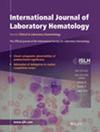Definition of Significant Platelet Clumping: Should We Review All Samples With a Platelet Clumping Flag From Automated Hematology Analyzer?
Abstract
Objectives
This study aimed to determine a definition for significant platelet clumping (PC) and evaluate the performance of the Sysmex XN instrument for detecting platelet clumps.
Methods
For part 1, 372 specimens with a ‘PLT_clump?’ flag in XN-9000 were classified into five groups according to the average number of PCs. We compared the initial platelet count (measured by XN-9000 using impedance method) and corrected platelet count (counted optically or re-analyzed by XN-9000 using vortexed or re-collected sample) of each group. For part 2, 1000 specimens with a PC flag divided into three subgroups {group N (PC = 0), Y (PC ≥ 1), and Z (microscopic fibrin clot)} and additional two groups {group S (PC(+) specimens without any flag and with flags of other categories) and group NC (negative control)} were collected. Positive predictive value (PPV), negative predictive value (NPV), sensitivity and specificity of PC detection of XN-9000 were obtained and the platelet counts and four indices (PDW, MPV, P_LCR, and PCT) of groups NC, N, Y, Z, and S were compared to detect PC more precisely.
Results
In part 1, all groups showed significant difference between the initial and corrected platelet counts. In part 2, PPV, NPV, prevalence, sensitivity, and specificity were 41.5%, 56.5%, 43.4%, 2.18%, and 98.3%, respectively. The platelet counts and four indices showed statistical differences for detecting PCs, and especially PDW and P_LCR were significantly smaller in group Z than group N or Y.
Conclusions
We suggest the definition of significant PC by the presence of at least three platelets. In addition, utilizing platelet-related indices should be developed to improve the efficiency of the PC detection.


 求助内容:
求助内容: 应助结果提醒方式:
应助结果提醒方式:


